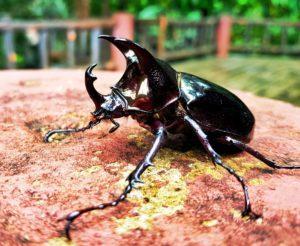Atlas beetle of the Scarabaeidae family has a striking appearance, notable for its enormous size and horned appearance (of the male). Mostly indigenous to different parts of Southeast Asia, the species has seven subspecies like Chalcosoma atlas atlas, and Chalcosoma atlas mantetsu.

Size: Male –60 – 130 mm (2.4 -5.1 inches); Female – 25 – 60 mm (0.98 – 2.36 inches)
Color: Like most other rhinoceros beetles, the atlas beetle has a greenish, grayish, or blackish coloration.
Other Characteristic Features: This species exhibits sexual dimorphism, with the males appearing larger than their female counterparts. One of the highlighting features is the three big horns that males have on the head and thorax. They use it as a weapon to fight against other males while seeking a prospective mating partner.
The larva has a creamy white grub-like appearance ill-reputed for their ferocity, going to the extent of biting when touched. When dwelling together, the larvae can end up fighting with each other, even killing their companions if food and living space is scarce.
The pupa has a reddish-green coloration, close to the adults in appearance.
Like most other beetles of the Scarabaeidae family, this species’ eggs are small and spherical with a pearly white coloration.
| Adult lifespan | 8 – 10 months |
| Duration of larval stage | 5 – 7 months |
| Distribution | Southeast Asia |
| Habitat | Mostly forests |
| Common Predators | Birds, bats |
| Seasons active from | July – August |
| Host Plants | Not recorded |
| Diet of larvae and adults | Larvae: Decayed wood Adults: Not recorded |
There have been no reports of any damage caused by these beetle species.
Image Source: lh3.googleusercontent.com, i.ytimg.com, biolib.cz, vistapointe.net
Atlas beetle of the Scarabaeidae family has a striking appearance, notable for its enormous size and horned appearance (of the male). Mostly indigenous to different parts of Southeast Asia, the species has seven subspecies like Chalcosoma atlas atlas, and Chalcosoma atlas mantetsu.

Size: Male –60 – 130 mm (2.4 -5.1 inches); Female – 25 – 60 mm (0.98 – 2.36 inches)
Color: Like most other rhinoceros beetles, the atlas beetle has a greenish, grayish, or blackish coloration.
Other Characteristic Features: This species exhibits sexual dimorphism, with the males appearing larger than their female counterparts. One of the highlighting features is the three big horns that males have on the head and thorax. They use it as a weapon to fight against other males while seeking a prospective mating partner.
The larva has a creamy white grub-like appearance ill-reputed for their ferocity, going to the extent of biting when touched. When dwelling together, the larvae can end up fighting with each other, even killing their companions if food and living space is scarce.
The pupa has a reddish-green coloration, close to the adults in appearance.
Like most other beetles of the Scarabaeidae family, this species’ eggs are small and spherical with a pearly white coloration.
| Adult lifespan | 8 – 10 months |
| Duration of larval stage | 5 – 7 months |
| Distribution | Southeast Asia |
| Habitat | Mostly forests |
| Common Predators | Birds, bats |
| Seasons active from | July – August |
| Host Plants | Not recorded |
| Diet of larvae and adults | Larvae: Decayed wood Adults: Not recorded |
There have been no reports of any damage caused by these beetle species.
Image Source: lh3.googleusercontent.com, i.ytimg.com, biolib.cz, vistapointe.net